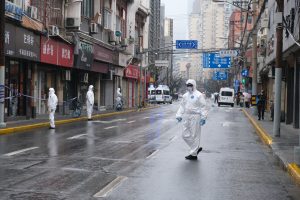Doctor On Call, or DOC for short, is a brand new series brought to you by Medical Channel Asia. This series aims to bring doctors and specialists from various fields to give you an introduction to common health and medical topics that you and the Asian population are interested in. In our 8th DOC, held on 9 March 2022 (Wednesday), from 8pm to 9pm (GMT+8), we have Dr Leong Hoe Nam, Senior Consultant Infectious Disease Specialist at Rophi Clinic, to talk to us about Long COVID – What Do We Know So Far?
For Part 1 of the forum, we have Dr Leong give us a presentation on the current research and knowledge about long COVID. In Part 2, Dr Leong goes through many questions posted by our enthusiastic audience, both collated from the registration process, and also posted LIVE. Read below to find out what more about this relatively new phenomenon arising from the pandemic – Long COVID.
Presentation by Dr Leong Hoe Nam
Introduction
COVID infection exists in phases. The first is the acute infection with overt signs and symptoms of a viral infection in the first 4 weeks. If signs and symptoms persist beyond 4 weeks with no alternative explanation, it is considered ongoing symptomatic COVID. Thereafter, there is Post-COVID19 syndrome, otherwise known as post acute sequelae of SARS-COV-2 infection (PASC), COVID long haulers, or just long COVID.
The definition of long COVID is not consistent, with different organizations assigning differing definitions. Generally speaking, it involves symptoms that last for a long duration, from weeks up to months from the onset of infection. It is a diagnosis of exclusion where symptoms cannot be explained by alternative diagnoses. Common reported symptoms involved are fatigue, shortness of breath, and cognitive dysfunction.
Pathophysiology of Long COVID
While the pathophysiology of long COVID is yet to be fully understood, there are some research behind these listed causes:
- Brain damage
- Damage to a vagus nerve / peripheral nerves
- Microclots, leading to poor perfusion
- Persistence of the virus
- Risk factors
- Type II Diabetes
- Genetic material from the SARS-CoV-2 virus in the blood
- Evidence of Epstein-Barr virus in the blood
- Presence of auto-antibodies
The pathophysiology of long COVID may not be limited to just one cause – there can be diverse injuries caused by the virus leading to similar symptoms. This “mix pot” of causes lead to the development of long COVID.
Symptoms of long COVID
The most common symptoms of long COVID include:
- Fatigue,
- Shortness of breath
- Sleep disturbances,
- Anxiety and Depression,
- Cognitive impairment
- Difficulty concentrating (brain fog)
These symptoms can be broadly characterized to two clusters – the “tiredness cluster” (the main cluster) encompassing points 1, 3-6; and the “respiratory cluster” involving point 2 (shortness of breath) as well as chest tightness and chest pain.
Children presenting with long COVID are also categorized in two clusters. 70% of children with long COVID start to improve after 3 months, while 30% of them may have more symptoms that goes on for a more prolonged period of time.
There can be other symptoms involved in other body systems, such as cardiovascular, gastrointestinal, musculoskeletal or even dermatological symptoms.
Statistics for long COVID
Prevalence of long COVID
On Jan 6, 2022, the UK Government’s Office of National Statistics (ONS) estimated that 2% of the UK population has long COVID with symptoms more than 4 weeks post-infection (self-reported statistics). In these 2% afflicted with long COVID, 64% (809,000) have their day-to-day activities affected to some degree, with 20% (247,000) of them affected to a great extent.
Risk factors for developing long COVID
Prevalence of self-reported long COVID was greatest in:
- People aged 35-69 years,
- Females
- People living in more deprived areas
- Those working in healthcare, social care, or teaching and education
- People with another activity-limiting health condition or disability
- Those with poor pre-pandemic health and poor general health, suffering from asthma, overweight or obese
Risk factors for long COVID in children:
- Children with pre-existing conditions such as
- Allergies
- Asthma
- Eczema
Treatment for long COVID
Currently, there are not many good treatment options for long COVID. Dr Leong suggests
- Reading up more about long COVID so as to support the patient
- Be empathetic to the patient
- Be encouraging to the patient
While medication may help to support the patient and lift their moods, it does not change the underlying problem of long COVID. With persistence and endurance, the patient can learn to embrace their condition and learn how to manage their day-to-day living.
Vaccination in long COVID
Improving long COVID symptoms
In an international survey involving 900 individuals with long COVID, 57.9% reported improvements in symptoms, 17.9% reported deterioration and the remaining participants had no change. Larger improvements were seen in those receiving the mRNA vaccines compared to adenoviral vector vaccines. Dr Leong proposed that the vaccination may have helped to “reset” the body’s immune system, which is in disarray post-infection.
Preventing long COVID
Several studies have looked into whether vaccination can reduce the occurrence of long COVID in individuals. Israeli data suggested that fully vaccinated participants who had also had COVID-19 had reduced symptoms of headaches (54%), fatigue (64%) and muscle pain (68%) which are features of long COVID.
Other papers looking at reduction risk of long COVID with vaccination can be found here, and here.
Can vaccination cause long COVID?
There is a small risk that vaccination may in turn result in the development of long COVID – as the vaccine is changing the immune response – but this risk is extremely low. The risk of developing long COVID post-infection is estimated at about 2%, so Dr Leong suspects that this risk with vaccination is much lower.
Final words
Long COVID is a rapidly changing field, and there is a chance of current definitions to change in time to come. There are many sufferers of long COVID but the understanding of the condition is still low.
Vaccinations are shown to both minimize the risk of long COVID developing, as well as the improvement of long COVID symptoms.
For those supporting patients with long COVID, we can seek to learn more about the condition, and be fully empathetic and supportive to the patient in their long road to recovery.
What’s next in store?
- See Part 2 for the Question and Answer (Q&A) segment with Dr Leong!
- If you have missed our previous DOC webinars, visit our Medical Channel Asia’s YouTube page, or you can also read the articles:
- Doctor On Call (DOC): Dr Sean Leo – Common Sports Injuries Part 1, Part 2
- Doctor On Call (DOC): Dr Lee Fang Jann – Men’s Health Part 1, Part 2
- Doctor On Call (DOC): Dr Felix Li – Medical Aesthetics Part 1, Part 2
- Doctor On Call (DOC): Dr Michael MacDonald – The Silent Killer Part 1, Part 2
- Doctor On Call (DOC): Dr Jade Kua – DARE to Save a Heart Part 1, Part 2
- Doctor On Call (DOC): Dr Radhika Lakshmanan – Facts and Myths of Breast Cancer Part 1, Part 2
- Doctor On Call (DOC): Dr Julian Tan – Ischemic Heart Disease Part 1, Part 2












